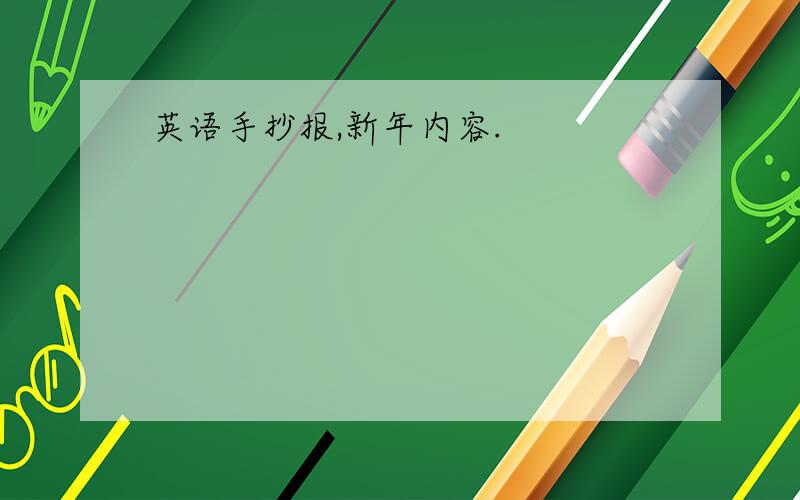英语手抄报,新年内容.
来源:学生作业帮助网 编辑:作业帮 时间:2024/04/28 03:53:41

英语手抄报,新年内容.
英语手抄报,新年内容.
英语手抄报,新年内容.
中国新年的日期,在各朝代并不相同.夏朝定在一月初一,商朝定在十二月初一,周朝定在十一月初一,秦朝定在十月初一.到西汉太初元年(公元前104年),汉武帝接受司马迁等人的建议使用《太初历》,恢复了夏历即农历,以正月为岁首,把二十四节气订入历法.后来历朝历代虽对历法有过修改,但基本上仍然以《太初历》为蓝本,以夏历的孟春正月为岁首,正月初一为元旦、元日,即新年的第一天.
1911年辛亥革命以后,清朝统治被推翻,孙中山在南京建立中华民国政府.各省都督府代表在南京召开会议,讨论历法问题.会上达成了“行夏历,所以顺农时;从西历,所以便统计”的共识,决定使用公历,把公历1月1日定做“新年”,把农历正月初一称做“春节”,但并未正式命名和推广.1949年9月27日,中国人民政治协商会议第一届全体会议通过使用“公历纪年法”,将公历1月1日定为“元旦”,把农历正月初一定名为“春节”,并规定春节放假三天,让人们热烈地庆祝农历新年.
在两千多年的历史进程中,我国的新年礼俗经历了萌芽、定型、裂变、转型的发展过程.
先秦时期,新年习俗处于萌芽阶段.此时的庆祝活动主要是在一年农事完毕之际,为报答神的恩赐而举行的“腊祭”.《诗经·七月》中记载了西周时期旧岁新年交替时的节庆风俗.诗中所谓“朋酒斯享,日杀羔羊,跻彼公堂,称彼觥,万寿无疆”,是说人们将美酒和羔羊奉献给诸神,以酬谢一年来神的保佑和赐福.这时的欢庆活动因各诸侯国采用的历法不一样而没有统一的日子,大致在冬天农闲之际,它是后来新年习俗的雏形.
新年习俗定型于汉代.经过战国和秦朝末年的社会大动荡后,西汉初期推行“休养生息”政策,社会生产得到了恢复和发展,社会秩序比较稳定,人们的生活情趣高涨,一系列节日习俗形成了.《太初历》推行后,历法长期稳定,正月初一作为新年的日期也因此得到确立.这样一来,原来各地区分别在冬末春初不同日子举行的酬神、祭祀和庆祝活动便逐渐统一在农历正月初一这一天进行.随着社会的发展,从汉朝到南北朝,正月初一过新年的习俗愈演愈烈,燃爆竹,换桃符,饮屠苏酒,守岁卜岁,游乐赏灯等活动都已出现,新年成为我国第一大节日.
新年习俗在唐代发生裂变.唐朝是思想文化昌明的时代,同时也是内外文化交流频繁的时代,新年习俗渐渐从祈祷、迷信、攘除的神秘气氛中解放出来,转变成娱乐型、礼仪型节日.元旦的爆竹不再是驱鬼辟邪的手段,而成了欢乐、喜庆的方式;庆祝新年的重点由祭神转向了娱人,转向了人们自己的娱乐游艺,享受生活.所以,可以说,也只有在唐代以后,新年才真正成为普天同庆,亿民欢度的“佳节良辰”.
新年习俗到明清时期转型.这种转型主要表现在两个方面:一是礼仪性、应酬性加强.人们在新年相互拜谒,达官贵人互送名帖,或者登门叩拜;平民百姓也讲究“礼尚往来”,馈赠礼品,互相拜年.二是游艺性进一步加强.新年期间,玩狮子,舞龙,演戏,说书,高跷,旱船等各种娱乐活动五彩缤纷,绚丽夺目.北京人逛厂甸,广州人游花市,苏州人听寒山寺钟声,上海人游城隍庙……各地游艺活动自具特色,各种娱乐活动层出不穷,令人眼花缭乱.这时的新年习俗将中国传统文化完美地融合起来,成为集中展示我国几千年风俗文化的民俗博览会.
两千多年的历史,中国的新年风俗盛行赤县神州,渗透到了每个人的生活之中,也铸造了每个炎黄子孙的灵魂.过大年,每到阴历年底赶回家与亲人团聚,祭祖宗,吃饺子,拜年,赏灯,这些已成为炎黄子孙共同的习惯.
中华过年习俗还辐射到周边其他国家,如日本、越南、朝鲜、韩国等国家,他们与我们以相似的方式庆祝新年.
Chinese New Year date, the dynasty not the same. Xia Dynasty scheduled in early January, the Shang Dynasty in early December, in early November for the Zhou dynasty, the Qin Dynasty in early October. Tachu to the first year of the Western Han Dynasty (104 BC), Han Wudi Sima Qian, who accepted the recommendations of the use of "Tachu calendar," and restore the Lunar XIA that, for the first month, living with the 24 Solar Terms of the calendar. Although later on the calendar Chinese dynasties have been modified, but still basically "Tachu calendar" a blueprint to XIA the Meng-Chun, living for the first month, the end of the day for New Year's Day, Yuanri, that is, the first day of the New Year.
After the 1911 Revolution of 1911, the rule of the Qing Dynasty was overthrown, Sun established the Republic of China government in Nanjing. Dudufu Nanjing, the provincial representatives held a meeting to discuss the calendar issue. At the signing of the "trip XIA, Shun ensure that the farming season from the western calendar, so they Statistics," the decision to use the Gregorian calendar, the calendar on January 1 custom "New Year", the end of the day of the Lunar New Year known as "Spring Festival", but has been formally named and promoted. September 27, 1949, the Chinese People's Political Consultative through the use of the first plenary session of "Annals of the Gregorian" calendar will be on January 1 as a "New Year's Day" is the beginning of the Lunar New Year will certainly entitled "Spring Festival", and that three-day Lunar New Year holiday, let people warmly celebrate the Lunar New Year.
In 2,000 years of history in the process, China's New Year customs experienced sprouting, stereotypes, fissile transition process of development.
Pre-Qin period, the New Year practices in its infancy stage. At this time of celebration activities mainly in the agricultural end of the year, to repay the gift of God and the "La Festival." "The Book of Songs July" recorded in the period of the Western Zhou Dynasty old at the turn of the New Year festive customs. Poems so-called "peer Andean enjoy wine, the lamb kill, Ji Gong Tang He said He statement of, Moshoumojiang" is that people will be dedicated to wine and lamb gods reward in the past year and God bless blessing. At this time of celebration activities because of the nobility of the country does not adopt the same calendar day and there is no uniform, Nongxian generally in the winter when it is the embryonic form of subsequent New Year customs.
New Year customs stereotypes in the Han Dynasty. After the end of the Warring States Period and the Qin Dynasty general social upheaval, the early Western Han Dynasty "to recuperate" policy, social production have been resumed and developed, stable social order and people's life goals high, a series of festive customs formed. "Tachu Calendar" after the implementation of long-term stability calendar, the end of the day as the date of the New Year, it has established. As a result, the various regions in the original Dongmochunchu different days at the Choushen, worship and celebration of the Lunar New Year will be gradually unified the end of the day to this day. With the development of society, from the Han Dynasty to the Northern and Southern Dynasties, the end of the day the custom of the South Korean activists packed growing, burning firecrackers for Zhaofu, Su Tu drink wine, Pu-year-old detainees and recreational activities such as Shangding have a New Year become China's first big festival .
New Year customs in the Tang Dynasty in fission. Tang is the era of ideological and cultural advances, but also frequent cultural exchanges both inside and outside of the times, New Year customs gradually from prayer, superstition, bustling addition to the mysterious atmosphere of liberation, transformed into entertainment, courtesy of festival. New Year's Day is no longer the firecrackers means Qugui evil spirits, and a joyous, jubilant way to celebrate the New Year by the focus to the entertainment of God, to the people their own entertainment games, and enjoy life. Therefore, it can be said, and only in the Tang Dynasty, the only truly celebrate the New Year, 100 million people celebrate the "Festival Liang."
New Year customs transition to the Ming and Qing Dynasties. This transition is mainly manifested in two aspects: First, etiquette, entertainment enhanced. People paid respects to each other in the New Year, the prestigious officials and others sent Mingtie each other, or, they Koubai; civilians also about "reciprocity", gift gifts, Betty each other. Second, entertainment and further strengthened. New Year period, playing the lion, dragon dance, acting, story tellers, stilt walkers, and other entertainment Hanchuan colorful, brilliant display. Beijingers Fair Yantian, Guangzhou people-goers, Suzhou people listen Hanshanshi bell, the people of Shanghai Chenghuangmiao…… travel around the unique entertainment activities, the endless variety of entertainment, dazzling. At that moment, the Chinese New Year customs will be perfect integration of traditional culture to become concentrated display of China's thousands of years of folk customs and culture Expo.
Over 2,000 years of history, the Chinese New Year customs prevalent in China Chek permeate everyone's life, casting the soul of the people of each. A celebration, the end of every lunar calendar rushes home to reunite with their families and ancestors were eating dumplings, Betty, and Shangdeng, these descendants of the Yellow Emperor has become a common habit.
Chinese New Year customs also radiation to the other neighboring countries, such as Japan, Vietnam, North Korea, South Korea and other countries, and they are similar to the way we celebrate theNew Year
上面是汉语,下面是英语.
春节,即农历新年,俗称过年,一般指除夕和正月初一。但在民间,传统意义上的春节是指从腊月初八的腊祭或腊月二十三或二十四的祭灶,一直到正月十五,其中以除夕和正月初一为高潮。春节历史悠久,起源于殷商时期年头岁尾的祭神祭祖活动。在春节期间,中国的汉族和很多少数民族都要举行各种活动以示庆祝。这些活动均以祭祀神佛、祭奠祖先、除旧布新、迎禧接福、祈求丰年为主要内容。活动丰富多彩,带有浓郁的民族特色。...
全部展开
春节,即农历新年,俗称过年,一般指除夕和正月初一。但在民间,传统意义上的春节是指从腊月初八的腊祭或腊月二十三或二十四的祭灶,一直到正月十五,其中以除夕和正月初一为高潮。春节历史悠久,起源于殷商时期年头岁尾的祭神祭祖活动。在春节期间,中国的汉族和很多少数民族都要举行各种活动以示庆祝。这些活动均以祭祀神佛、祭奠祖先、除旧布新、迎禧接福、祈求丰年为主要内容。活动丰富多彩,带有浓郁的民族特色。
收起
正常排版,再找相关内容